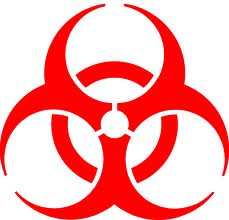Regulated Medical Waste
 What is Regulated Medical Waste (RMW)?
What is Regulated Medical Waste (RMW)?
It is defined, in 6NYCRR part 360, as any medical waste generated in the diagnosis, treatment, (e.g., provision of medical services), or immunization of human beings or animals, in research pertaining thereto, or in the production or testing of biologicals. Certain exclusions and exemptions apply. NOTE: The term "solid waste" includes solid, semi-solid, or liquid materials. Vomit, unless continuing visible blood, is not a RMW. See procedure for cleaning up vomit.
What exactly does that mean?
The regulation spells this out a bit more:
- Cultures and stocks of infectious agents and associated biologicals, including: cultures from medical and pathological laboratories; cultures and stocks of infectious agents from research and industrial laboratories; wastes from the production of biologicals; discarded live and attenuated vaccines; and culture dishes and devices used to transfer, inoculate, and mix cultures.
- Human pathological wastes, including tissues, organs, body parts and body fluids that are removed during surgery or autopsy, or other medical procedures, and specimens of body fluids and their containers. Tissues fixed in preservatives such as formaldehyde and Wardsafe are not RMW.
- Liquid waste, human blood, products of human blood, items saturated and/or dripping with human blood, or items that were saturated and/or dripping with human blood that are now caked with dried human blood, including serum, plasma, and other blood components, and their containers, which were used or intended for use in either patient care, testing and laboratory analysis or the development of pharmaceuticals. Intravenous bags are also included in this category.
- Sharps that have been used in animal or human patient care or treatment or in medical, research, or industrial laboratories, including hypodermic needles, syringes (with or without the attached needle), pasteur pipettes, scalpel blades, blood vials, needles with attached tubing, and culture dishes (regardless of presence of infectious agents). Also included are other types of broken or unbroken glassware that were in contact with infectious agents, such as used slides and cover slips.
- Contaminated animal carcasses, body parts, and bedding of animals that were known to have been exposed to infectious agents during research (including research in veterinary hospitals), production of biologicals, or testing of pharmaceuticals.
- Wastes from surgery or autopsy that were in contact with infectious agents, including soiled dressings, sponges, drapes, lavage tubes, drainage sets, underpads, and surgical gloves.
- Laboratory wastes from medical, pathological, pharmaceutical, or other research, commercial, or industrial laboratories that were in contact with infectious agents, including slides and cover slips, disposable gloves, laboratory coats and aprons.
- Dialysis wastes that were in contact with the blood of patients undergoing hemodialysis or renal dialysis, including contaminated disposable equipment and supplies such as tubing, filters, disposable sheets, towels, gloves, aprons, and laboratory coats.
- Biological waste and discarded materials contaminated with blood, excretion, exudates, or secretion from humans who are isolated to protect others from certain highly communicable diseases, or isolated animals known to be infected with highly communicable diseases.
- The following unused, discarded sharps: hypodermic needles, suture needles, syringes, and scalpel blades.
NOTE: Materials that are considered RCRA hazardous, household waste or things that have been treated and are no longer exhibit infectious characteristics (e.g. items which have been autoclaved) are not Regulated Medical Waste.
Who generates Regulated Medical Wastes on campus?
-
Student Health Center
-
Athletics
-
Biology
-
Custodial
-
Chemistry
-
Students/Faculty/Staff/Visitors who use needles and syringes
How do I dispose of my RMW?
The Student Health Center, Athletics, Biology, Custodial and Chemistry Departments all maintain a service that picks-up, transports and disposes (incinerates) the RMW. Any students using needles and syringes on a regular basis, may stop by the Student Health Center and pick up a sharps shelter/container for their personal use and return it when full, for disposal. Anyone, including students, faculty/staff or visitors, may deposit used needles and syringes in any sharp shelter/container location.
What are the packaging requirements while filling an active container?
-
Sharps shelter/containers must be red or labeled with the words "infectious" or "regulated medical waste."
-
Anything not going in a sharps shelter/container, must be placed in a red plastic bag or one with the universal biohazard symbol, shown above. The The plastic bag must be placed in an outer container (such as a box or garbage can) that has a tight fitting lid and is labeled with the words "infectious" or "regulated medical waste."
-
Both of the aforementioned containers shall be free of residue and in good repair and shall not be left outside exposed to the elements. Public exposure to the containers shall be limited.
-
Sharps shelters and inner packaging (a.k.a. the bag) must be labeled in permanent ink or water-resistant tags, the following: generator's name and address.
-
The outer shipping container must contain the following information: generator's name and address, transporter's name, transporter's state permit or ID number, date of shipment, identification of contents as "medical waste." The transporter which the College uses, labels the outer shipping containers with this information.